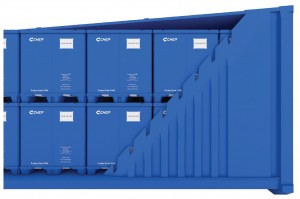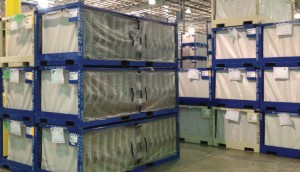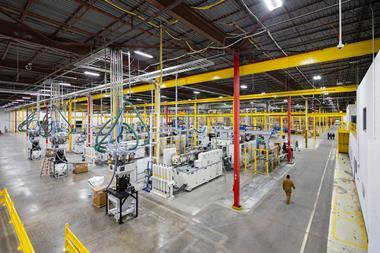What influences OEMs and suppliers in their decision to own or outsource packaging in different regions? The approaches vary considerable and depend on factors ranging from the existence or non-existence of standards, as well the types of parts flows

The automotive industry is a tremendous user of returnable packaging. A visit to any carmaker’s factory or logistics centres will feature a steady flow of plastic and steel containers, crates, totes and pallets moving from trailers through crossdocks, loading bays and parts supermarkets, on to the assembly line and often all the way back to suppliers again. However, the makeup, ownership and management of these packaging resources vary widely by manufacturer.
An OEM might well own its container fleet throughout a regional supply chain, feeding boxes across its tier suppliers, through its freight network to factories and back again. In some segments, carmakers will rely on the tier supplier to supply its own packaging for factory bound parts, or even manage all of the boxes but keep the assets on suppliers’ books. In other cases, third party providers could own part or even all of the returnable packaging fleet for an OEM, renting it for use and pooling equipment across multiple manufacturers.
Opinions differ on the best strategy, or on whether or not there is a trend one way or another. Ford has made a clear decision to own more of its overall packaging, as opposed to leaving it to suppliers, in an effort to control cost and quality (read here). However, such trends are hard to distinguish, since regional standards play a big role. In Europe, where there is a wider-used standard on totes, pooling between manufacturers is more common, including for Ford. In North America, where standards and sizes vary, manufacturers tend not to share assets. In emerging markets, such as China, the lack of standards also appears to hold back wider, outsourced packaging pools, however providers see substantial opportunity to improve packaging management.
The case for outsourced packaging
As packaging producers Schoeller Arca and Linpac Allibert merge to become Schoeller Allibert, the combined company is transitioning from being a container producer to a more comprehensive provider of services related to packaging. For example, it is offering a new service for container management and pooling called 360 Degree. Stefan Schweiger, global business development director, says that most of Schoeller Allibert’s automotive customers want to own their packaging, particularly in North America and in China. However, Schweiger says he sees an overall trend in the automotive industry towards outsourcing both the ownership and management of reusable containers. Among the reasons for outsourcing ownership is uncertainty about the length of time that particular containers will be in use, as well as high loss and damage rates.

Phil Biga, senior project manager at packaging solutions provider Surgere, agrees, and says that Surgere’s most common arrangement is to own and manage its customers’ container pools. He suggests that outsourcing offers more flexibility for manufacturers in using its packaging assets, particularly as they tend not to put the right resources into tracking the fleet. “Companies do not know what they have or the value or location of their assets,” says Biga.
Last year, Surgere launched Packaging as a Service (PaaS), which helps to reduce large capital outlays that traditionally fund reusable container deployments at the beginning of a model launch or update. The company also works to improve container utilisation. For instance, Biga says it discovered that one OEM’s container returns were taking three to four days longer than planned. Surgere worked with the carmaker customer of tier one supplier IAC, based in Southfield, Michigan, to improve the container return frequency and to determine the right number of containers in the loop. The initial result was a reduction in IAC’s container return time by two days.
Luca Rossi, vice-president, automotive and industrial solutions for Europe at container and pallet pooling provider Chep, estimates that the company’s services for container purchasing, storage, maintenance, management, return, and disposal can help companies to save as much as 25%. The pooling process is customised to the number of containers that manufacturers need, and can reduce transport costs by moving containers in from the closest locations.
One user of Chep’s services is tier one supplier Bosal International Management, based in Lummen, Belgium. Bart Broekmaat, group transportation manager at the company, says it uses Chep as its pool provider for pallets and small containers that move between its plants. “The benefits of this system include the availability of containers within our European network and having the same transport company handle the round trip,” says Broekmaat.
Bosal also pools various types of company-owned steel containers in Europe, which it uses with some of its suppliers. It manages its own flows, shipping full truckloads (FTL) between plants. “However, we do not keep track of individual containers since they are not barcoded,” reveals Broekmaat. “The challenge is that we have less visibility of the containers in our pool due to a lack of management information, which results in sub-optimal transportation,’ he says. “Therefore, we are investigating possibilities to change to a different method of packaging in order to avoid transporting empty containers.”
A newcomer in the container management and logistics industry is Palogix International Supply Chain Services, which started operations in autumn 2012 and currently serves automotive tier one suppliers as well as commercial equipment manufacturers Caterpillar, CNH, and John Deere. Its services include the management of returnable container transportation between the United States and Mexico.
“We are working to acquire a high-and-heavy OEM’s fleet of 750,000 containers for $116m,” says president and CEO Michael J. Meier, “We want to reduce the number of different container sizes from 50 to 25.”
Different models for different regions
While some packaging pooling providers point to outsourcing trends for containers, the levels vary by region. Chep’s Rossi explains that in North America, OEMs and tier one suppliers typically do not share standard packaging within a pooled environment, whereas it is more prevalent in Europe.
Dan Roovers, vice-president of global automotive sales at Orbis Corporation, says part of the reason this sharing is more common in Europe is because in North America, OEMs increasingly want to own their packaging. “Instead of pushing tier one suppliers to own the containers, as was the case, Ford and Toyota are interested in purchase packaging directly [in North America],” says Roovers. “The reason is that owners save money in dealing with the packaging supplier. There are no hidden costs, such as reimbursing the tier one on packaging through the piece price. For large OEMs, the lowest cost option is to own their packaging.”
While he notes that there is more outside ownership in Europe than in North America, he also suggests the trend is actually starting to move away from that.
There are other differences between the two regions, particularly as relates to sizes and standards. Container and dunnage sizes are more diverse in North America than in Europe, which is part of what makes pooling across manufacturers more complicated.
"We are working to acquire a high-and-heavy OEM’s fleet of 750,000 containers for $116m. We want to reduce the number of different container sizes from 50 to 25" – Michael J. Meier, Palogix
Roovers also sees a tendency away from third party providers owning packaging in China. “In China, manufacturers want to buy their packaging as cheaply as possible and OEM ownership of packaging is more of the norm. Moreover, since there is no standardisation among truck sizes in China, outsourcing containers is more difficult because it is too chaotic,” he states.
He adds that the concept of returnable packaging loops is still relatively new in China, and the lack of standard truck and container sizes, along with joint venture structures at carmakers, makes managing such a loop more complicated. For example, many manufacturers and providers are still learning how best to administer milkruns. “The tier one suppliers have put up resistance to owning containers and are pushing the OEMs to own their packaging, but because of complexities, such as joint ventures, this concept [returnable packaging loops] is less prevalent in China,” says Roovers.
On the whole in China, packaging is about 60% returnable and 40% expendable, according to Roovers. He thinks there is opportunity for third party providers to manage Chinese OEMs’ packaging from the beginning. The big issue is implementing the system loop, he says. For Chinese and European joint ventures, however, he notes that there tends to be some European influence on packaging systems.
Chep’s Rossi says it is common to see a variety of approaches within joint venture OEMs in China. For example, companies may use durable packaging extensively, one-way packaging, or a combination of both. He points out the growing trend to replace cardboard packaging with returnable containers, regardless of whether they are owned by OEMs, tier suppliers or pooling companies.
Phil Biga at Surgere points out that in many emerging markets, the cost of labour is cheaper than is the cost of technology, which makes the case for some container pooling providers less compelling. “Even so, we are seeing a trend away from replacing bad processes with additional people,” he says.
 Returnable packing accounts for around 60% of that used in China
Returnable packing accounts for around 60% of that used in ChinaReturning across the seas
There does appears to be a growing interest in the industry to increase the use of returnable packaging for international shipments. One issue is standards, however. In North America, standard footprints are imperial, compared to metric in Europe, which means that containers cannot typically flow between the two continents.
In September 2012, Chep launched the IcoQube range of products that targets the overseas movement of materials. The IcoQube can bridge the gap between the company’s North American and European fleet of containers. It is stackable, which increases shipping capacity by 8% to 10% compared to conventional disposable packaging, according to Rossi. The IcoQube uses up to 98% of sea container space and has a foldable ratio of 9.5 to 1.
Orbis’s Roovers says that one of the main goals of packaging is to fit more components into a truck or sea container. To better use carrier space, Orbis introduced a new pallet to Toyota in May. The heavier duty pallet lasts 35% longer and more empty pallets can fit on the truck – 884 on a 53ft truck compared to 780 of the old ones. Orbis also introduced its NXO handheld tote in January, which has a moulded in-textured label surface for easy label removal. This eliminates the need for the older style tote with label placards on which to adhere a standard inventory label.
There are some types of packaging that move regularly between continents, including Goodpack’s returnable bulk containers for sea containers. European sales director Colin Howard says its MB5 container provides a 10-20% increase in the load factor of a sea container. Currently it is increasing the height of its MB5 to accommodate high-cube containers.
Howard believes there is more opportunity to manage packaging flows to and from emerging markets. He says that the system that exists between the US and Europe can be replicated for shipments from Europe to Russia, for example.
He adds that a challenge in many emerging markets is that they may not have good freight balances. For example, South Africa has many inbound containers, but not a lot of outbound ones. “One can address this by using standardised containers for other projects. In other words, [ship] in with auto parts and out with juice or rubber.”
"In China, manufacturers want to buy their packaging as cheaply as possible and OEM ownership of packaging is more of the norm" – Dan Roovers, Orbis
With considerable money wasted each year through lost containers, IT services can be an important part of a packaging pooling service, particularly in tracking assets, but also in managing the movement and flow of containers.
Surgere offers its Container Optimisation Solution, COS 2.0 – container management software that assists with packaging specifications, planning for every part, location and disposition, and sourcing. It helps to manage RFID technology, which is integral to the tracking and inventory control of parts and containers; IAC is among its users. Biga says that COS 2.0 enables packaging loops to remain balanced, thus decreasing the risk of line shutdowns.

Albert Seecharan, president of Orbis Reusable Packaging Management, part of Orbis Corporation, says the company’s SmartTrak service integrates with a customer’s ERP system to help it manage its own loop. “SmartTrak, which when integrated with the customer’s ERP, expedites transportation, reduces stock outs, and enables shorter routes and more efficient packaging,” he says.
Schoeller Allibert also offers container management software. “At this point, container and content information are separate,” says Schweiger. “In the future we will tie together information technology for the container, the tier one supplier and the OEM.”
Meanwhile, Palogix tracks returnable containers using RFID tags, which alleviates the problem of loss. Meier says it can offer overall savings of 10% with the help of a track-and-trace service that decreases dwell time, increases inventory velocity, and returns containers more quickly.
"At this point, container and content information are separate. In the future we will tie together information technology for the container, the tier one supplier and the OEM" – Stefan Schweiger, Shoeller Allibert
Partners in packaging
For any packaging loop to take form, there must be standardisation as well as a degree of collaboration. Chep’s Rossi says that although more standards are emerging in durable packaging, most OEMs are reluctant to collaborate with each other and to get the real value of pooling. This mindset is consistent in both emerging and developed markets, he says.
But there are signs of other partnerships taking place that could support a more integrated management of containers. Schweiger says that Schoeller Allibert is now establishing cooperation with producers of container management software, logistics providers and inlay providers. “The trend is to save on transportation costs. Now, we are trying to cooperate with logistics service providers, which is important to achieving an intelligent container flow,” he says.
Surgere is working with Recon Logistics, Pro-Trans, and UTi Logistics to try to reduce transport costs for its customers. “Our partnerships with these companies focuses on how packaging improvements can increase transportation efficiency and reduce damage,” says Biga.
These partnerships suggest that, whether it’s an owned or rental model, many in the logistics chain are recognising the importance of both tracking and maximising the use of container assets.

























![Global[1]](https://d3n5uof8vony13.cloudfront.net/Pictures/web/a/d/s/global1_726550.svgz)










